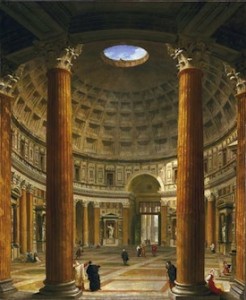For Monty Python fans the question “What have the Romans ever done for us ?” will recall the irreverent comedy of the film ‘The Life of Brian’ when Reg the leader of the “The People’s Liberation Front of Judea” asks the question to his followers. What ensues is not the overwhelming call to arms against the imperialist aggressor he’d hoped for …
Reg : All right… all right… but apart from better sanitation and medicine and education and irrigation and public health and roads and a freshwater system and baths and public order… what have the Romans done for us? Xerxes : Brought peace! Reg : (very angry, he’s not having a good meeting at all) What!? Oh… (scornfully) Peace, yes… shut up!
There is a serious question behind this frivolous skit. The Roman Empire and the culture it exported was the most advanced the world had ever seen. Indeed after the fall of the Roman Empire it never got back up to the same level, in Western Europe, until many centuries later. In this article we look at 5 of the (better) things that the Romans introduced to mankind.
1. Concrete

Many ancient Roman structures like the Pantheon, the Colosseum and the Roman Forum are still standing today thanks to the development of Roman cement and concrete. The Romans first began building with concrete over 2,100 years ago and used it throughout the Mediterranean basin in everything from aqueducts and buildings to bridges and monuments. Roman concrete was considerably weaker than its modern counterpart, but it has proved remarkably durable thanks to its unique recipe, which used slaked lime and a volcanic ash known as pozzolana to create a sticky paste. Combined with volcanic rocks called tuff, this ancient cement formed a concrete that could effectively endure chemical decay. Pozzolana helped Roman concrete set quickly even when submerged in seawater, enabling the construction of elaborate baths, piers and harbours.
⇒ Related article : Cement and Concrete
2. Latin, the eternal Language

As the Romans carved out their empire so they also brought with them their language. The language of their army was Latin, so too was it the language of the governors and office workers in the provinces of the empire. Lasting witness to this language which was once spoken all over the ancient empire, are the many languages which in time developed from it. French, Italian, Portuguese, Rumanian, Spanish… All these languages have developed out of Latin.
The Catholic church still speaks and prays in Latin today, indeed the Pope, is still today called the Pontifex Maximus (the greatest high-priest).
3. Book Binding

For most of human history, literature took the form of unwieldy clay tablets and scrolls. The Romans streamlined the medium by creating the codex, a stack of bound pages that is recognized as the earliest incarnation of the book. The first codices were made of bound wax tablets, but these were later replaced by animal skin parchment that more clearly resembled pages. Ancient historians note that Julius Caesar created an early version of a codex by stacking pages of papyrus to form a primitive notebook, but bound codices did not become popular in Rome until the first century or thereabouts. Early Christians became some of the first to adopt the new technology, using it extensively to produce copies of the Bible.
4. Metalled Roads and Road Networks

At its height, the Roman empire encompassed nearly 1.7 million square miles and included most of southern Europe. To ensure effective administration of this sprawling domain, the Romans built the most sophisticated system of roads the ancient world had ever seen. These Roman roads—many of which are still in use today—were constructed with a combination of dirt, gravel and bricks made from granite or hardened volcanic lava. Roman engineers adhered to strict standards when designing their highways, creating arrow-straight roads that curved to allow for water drainage. The Romans had built over 50,000 miles of road by 200 A.D., primarily in the service of military conquest. Highways allowed the Roman legion to travel as far as 25 miles per day, and a complex network of post houses meant that messages and other intelligence could be relayed with astonishing speed. These roads were often managed in the same way as modern highways. Stone mile markers and signs informed travelers of the distance to their destination, while special complements of soldiers acted as a kind of motorway patrol.
5. The Julian Calendar

The modern Gregorian calendar is modeled very closely on a Roman version that dates back more than 2,000 years. Early Roman calendars were likely cribbed from Greek models that operated around the lunar cycle. But because the Romans considered even numbers unlucky, they eventually altered their calendar to ensure that each month had an odd number of days. This practice continued until 46 B.C., when Julius Caesar and the astronomer Sosigenes instituted the Julian system to align the calendar with the solar year. Caesar lengthened the number of days in a year from 355 to the now-familiar 365 and eventually included the 12 months as we know them today. The Julian calendar was almost perfect, but it miscalculated the solar year by 11 minutes. These few minutes ultimately threw the calendar off by several days. This led to the adoption of the nearly identical Gregorian calendar in 1582, which fixed the discrepancy by altering the schedule of leap years.
⇒ Related article : Anno Domini – Origin of the Western Calendar




